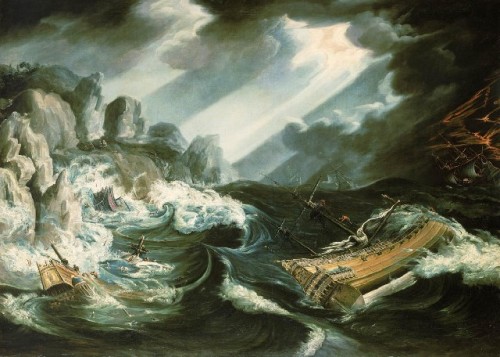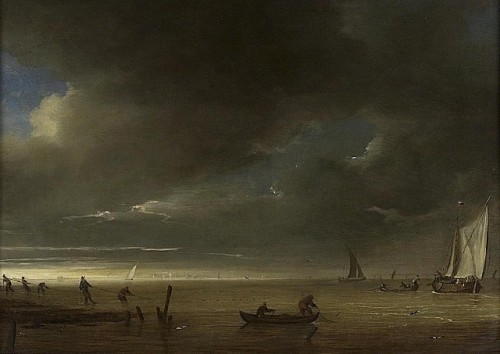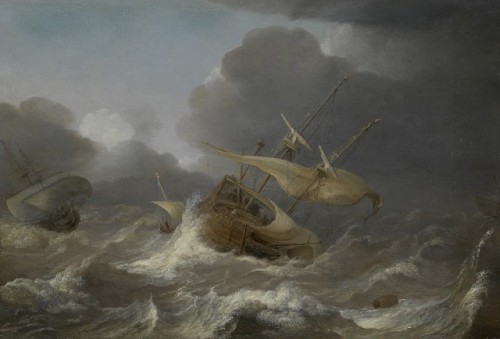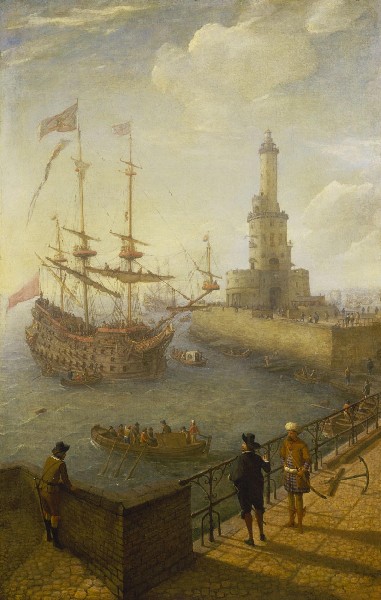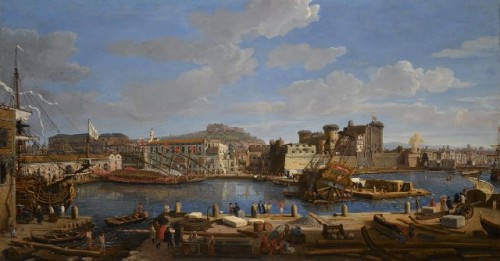The Golden Age of Dutch Seascapes at Peabody Essex Museum
Salem Exhibition Explores Colonial Power
By: Shawn Hill - Jun 10, 2009
The Golden Age of Dutch SeascapesJune 13—September 7, 2009
Peabody Essex Museum
East India Square
Salem, MA
The curators of this travelling show have given us a fresh insight into that glistening period of Dutch painting history, the 17th century. By focusing on seascapes, they allow us to see the world through the eyes of a colonial power. The ships become cultural envoys, bastions of preservation (and, certainly, at times of invasion) of Western European values from a mercantile society that was interested in spreading those values to the ends of the world.
Surprisingly, there's little really of other countries in this show (the exotic for these painters seems to consist largely of Italy and the rest of the Mediterranean coastline), and not all that much of the Dutch coast. Many paintings feature rocky vistas, craggy breakers, and violent undertows of the sort seldom seen along the Dutch shoreline. Instead the show makes sure to point out that these paintings, especially their landscape features, and the details of the ships themselves, are as much metaphors as they are actual observations.
National flags fly high and clear in many of these images (in one case even the colors of a rainbow are limited to patriotic red, white and blue), as do crests, seals and other emblems. Figures are tiny, but they're visible on the masts and decks of several ships, though they seldom receive the detail lavished on the decorative features of the ships themselves. Even more prominent, in several cases, are religious symbols, reflecting the ongoing struggles in the Baroque era between retrenching Catholicism and surging Protestant belief.
To bring these symbols to the forefront (in what might otherwise be a show of easily dismissed prettiness), the curators have staged five different thematic groupings in as many rooms. The bracketing rooms are respectively The Sea, A New Subject (as opposed to portraiture and still life, the already established artistic products of the time) Patronage, Battles, and the Exotic (i.e., the pomp and circumstance of military fervor and allegiance).
For me, both rooms were eclipsed by what went between; A Sea of Symbols, Vistas of the Netherlands, and Far Horizons. In the first, the idea of seascapes as metaphorical visions is clearly presented. Here we see storm-tossed seas, and grim fates for several doomed ships. Are there premonitions of Gericault's forlorn "Raft of the Medusa" in some of these calamities? Certainly there's a later influence on Turner's romantic vistas, especially works like "The Slave Ship" (which contrasts violent, colorful skies with tiny drowning figures in chains). Turner was the former owner of one of the paintings on display.
"The Wreck of the Amsterdam" shows at least six ships in various stages of distress off a rocky coast. This 1630 painting from the Flemish School (no more specific attribution has been confirmed) moves dramatically from right to left, beginning with a ship menaced by dreaded red skies. Closer to the shore a larger ship heaves and lists, about to founder and crash into the coast as a third ship has done. One piece of wreckage, clung to by desperate sailors, features a glowing nimbus of the Virgin, a bit of carving called to life as if by their prayers.
We don't know if this dramatic narrative is really a catastrophe of several ships, or if it's the same ship in several stages of destruction. But the slanting diagonals of the waves and the hulls, and the movement from dark storminess to clear skies (and the glowing Virgin) on the right makes the religious message of salvation hard to ignore.
Jan Porcellis offers some of the most realistic works on display. "Fisherman on the Shore Hauling Their Nets" (1630) features a drab, sodden activity in glistening detail, gray and brown, shining under dark blue clouds. "Dutch Ships in a Gale" (1620), on the other hand, shows a beleaguered vessel, sails at half mast, struggling to maintain purchase on waves surging unpredictably from peaks to valleys.
The local vistas in the third section also occasionally feature dangerous storms, but set against the profiles of highly decorated and whole ships standing up under the onslaught. The ornate details of Baroque embellishment cover the cabins of the ships, promises of a strong link to society and culture even while away from home, more commonly as in a work by Jan Van de Cappelle "Dutch Shipping in a Calm Sea" from 1651. The ocean under his sturdy boats is as flat and reflective as glass, while sailors calmly work on the rigging high above.
The images of foreign ports foretell the artistic styles to come. Caspar van Wittel's "The Darsna Della Galere and Castello Nuovo at Naples" from 1703 looks like a Canaletto, an orderly and brilliantly lit vision of an Italian port in a flurry of activity, the docks flanked by architectural wonders arranged in clear perspective and visible in every detail. Pieter Mueller (also known as Tempesta for his ability to represent stormy seas) is here represented by the calmer "A Fresh Breeze in the Mediterranean" (1690), but the sails on the ship in the foreground are swollen with energy, giving it a sense of speeding along on course.
Abraham Willaerts offers an unusual image in "A Spanish Three Decker at Anchor off Naples." The odd vertical composition shows the Spanish ship in the harbor reaching the same height as the elaborate lighthouse on the shore. Observing the scene are three men leaning on an up-close rail, two in Dutch attire, but the third is wearing a turban and a curved sword. It's a strange vista of cultures meeting, and the asymmetry of the various elements gives a sense that anything could happen next.
The "exotic" in the final room mostly refers to India, but its depiction is in the style on display everywhere else; the emphasis is on the Dutch military, their conquests and battles. The Dutch taste for orderliness and the finer things shown in great detail extended to their fleet, and hints of other cultures become colorful embellishments to an established world view. The tiny figures seen as details in these horizons of sea and sky seem fragile and imperiled, fleeting presences in the grand scale of creation. The tiny crosses that gleam on more than one promontory offer warnings as well as sanctuary.

